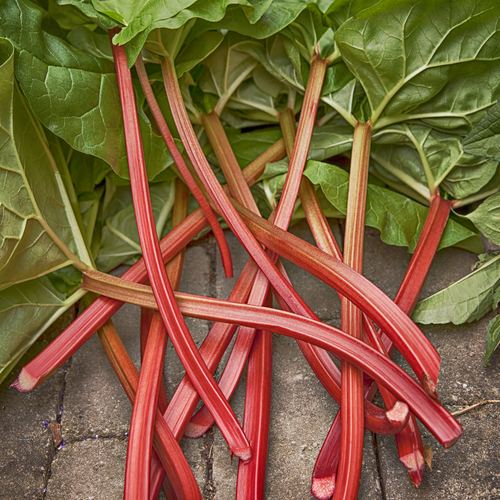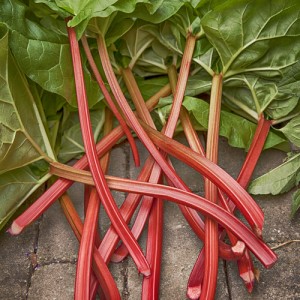 [1]Rhubarb is more versatile than we give it credit for. Its stalk are a favorite for culinary uses, but there is more to it than meets the eye.
[1]Rhubarb is more versatile than we give it credit for. Its stalk are a favorite for culinary uses, but there is more to it than meets the eye.
This perennial favorite is very easy to grow and makes a popular addition to low maintenance gardens. Rhubarb is an extremely hardy plant, and can grow in almost any climate. Rhubarb can be propagated by dividing the crown and planting it. Divisions from 4-5 year old crowns should be taken in the spring. Plant the divisions near roses, asparagus and strawberries, as these are companion plants.
It is best to allow the plant to grow the first year and harvest the following year when the foliage spread and stalks reached sufficient girth of about one to two inches thick. The top greens are usually discarded, as they contain unusually high amounts of oxalic acid. When this acid is consumed in high amounts it can cause severe symptoms such as burning in the eyes, mouth, and throat; skin edema, difficulty breathing. In serious cases, it can result in kidney failure, convulsions, coma, and death. Therefore, stick to using the stalks of rhubarb for cooking.
Rhubarb also contains many nutritional benefits including:
- Rhubarb contains some vital phyto-nutrients such as dietary fiber, polyphenolic antioxidants, minerals, and vitamins. Further, its petioles contain no saturated fats or cholesterol.
- The stalks are rich in several B-complex vitamins such as folates, riboflavin, niacin, vitamin B-6 (pyridoxine), thiamin, and pantothenic acid.
- Red color stalks contain more vitamin A compared to the green varieties. Further, the stalks also contain small amounts of polyphenolic flavonoid compounds like beta-carotene, zea xanthin, and lutein. These compounds convert to vitamin A inside the body and deliver same protective effects of vitamin A on the body. Vitamin A is a powerful natural anti-oxidant and is required by the body for maintaining the integrity of skin and mucus membranes. It is also an essential vitamin for healthy eyesight. Research studies suggest that natural foods rich in vitamin A help the body protects against lung and oral cavity cancers.
- As in other leafy greens, rhubarb stalks also provide good amounts of vitamin K. 100 g of fresh stalks provide about 24% of daily recommended intake of this vitamin. Vitamin K has a potential role in bone health by promoting osteotrophic (bone formation and strengthening) activity. Adequate vitamin K levels in the diet help limiting neuronal damage in the brain; thus, has established role in the treatment of Alzheimer’s disease.
- Its stalks also contain healthy levels of minerals like iron, copper, calcium, potassium, and phosphorus. However, most of these minerals do not absorb into the body as they are subject to chelating into insoluble complexes by oxalic acid, and excreted out from the body.
Source [2]
The Medicinal Side of Rhubarb
Rhubarb has a wide range of medicinal uses as well. The rhubarb root is one of the most popular herbs in traditional Chinese medicine and was first documented in an ancient text written 2,200 years ago called the Divine Husbandman’s Classic of Materia medica. Originally, herbalists used rhubarb as a laxative, and to evacuate the bowels and improve the digestive tract. However, they found it was also useful in treating jaundice, endometriosis, and if applied topically would help burns and skin ulcers. Moreover, rhubarb has the ability to fight infectious fungi such as candida, and infections of the lungs and eyes.
The root of a six-year-old rhubarb plant is harvested in the fall and dried for later use. The dried root is usually ground into a fine powder or used in a tonic to treat a diverse amount of ailments including a natural way to lower cholesterol, as an antiseptic, antispasmodic, antitumor, astringent, promotes the flow of bile from the gall bladder, soothes and protects irritated mucous membranes, diuretic, is a purgative, stomachic and tonic. When taken internally in small doses, rhubarb also acts as an astringent tonic to the digestive system, when taken larger doses rhubarb acts as a very mild laxative. Rhubarb has also been shown to exert protective effects on severe acute pancreatitis in rats, probably by inhibiting the inflammation of the pancreas, improving pancreatic microcirculation, and altering exocrine secretion.
According to this article [3], one can make a decoction using rhubarb roots. Herbalists recommend putting 1-1.5 teaspoons of pulverized, crushed rhubarb root in one cup of boiling water and letting the mixture for 10 minutes. The tea can be taken twice a day. Most herbal preparations of rhubarb, however, are individually prepared for each patient. Rhubarb may be combined with other herbs.
Warnings and Side Effects of Using Rhubarb Medicinally
There are warnings and side effects of using rhubarb medicinally.
- Rhubarb should not be taken by children under the age of 12
- Women who are pregnant or nursing should not use rhubarb.
- It should also not be taken by patients with acute or chronic intestinal disorders, such as Crohn’s disease.
- Due to a possible loss of potassium, rhubarb root should not be taken in combination with cardiac medications, diuretics or steroids. Loss of potassium can be decreased by combining rhubarb root with licorice root.
The most common side-effect noted with rhubarb is abdominal cramping; however, this condition is often relieved by reducing rhubarb dosage. Excessive use of rhubarb can lead to nausea, vomiting, diarrhea, and possible liver and damage of the kidneys. Rhubarb should not be used medicinally for long term as it can lead to cirrhosis of the liver and hypokalemia (a metabolic imbalance characterized by low potassium levels in the blood).
As always, make sure to consult with a licensed, qualified healthcare professional before taking rhubarb or any other dietary supplement.
To conclude, rhubarb is a noteworthy addition to your garden and can be grown in any climate. Consider adding this vegetable to your garden for its unique flavor, nutritional properties and its many medicinal qualities.
